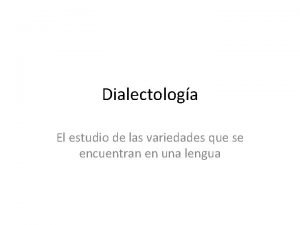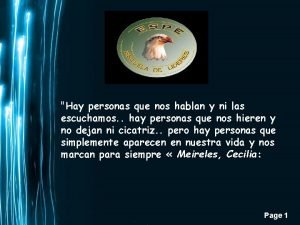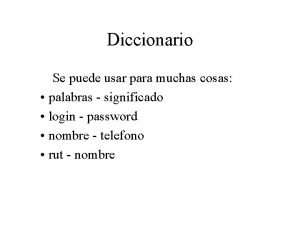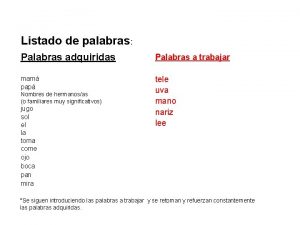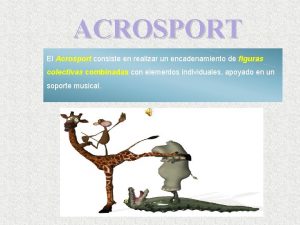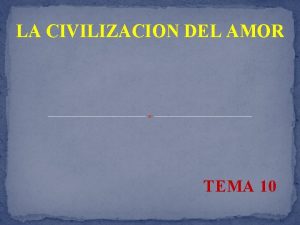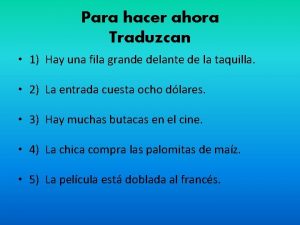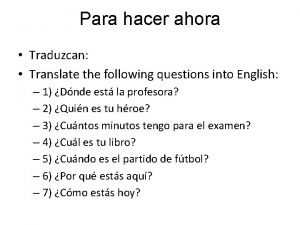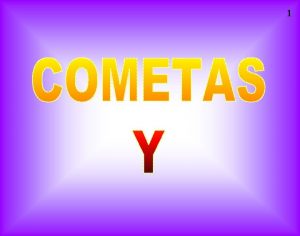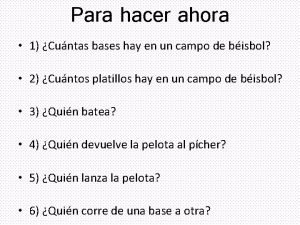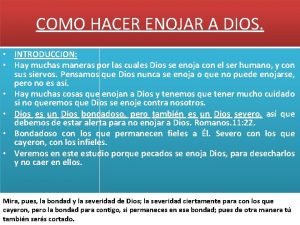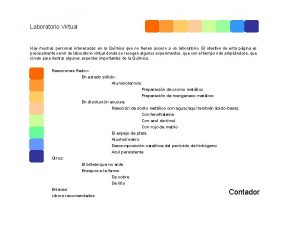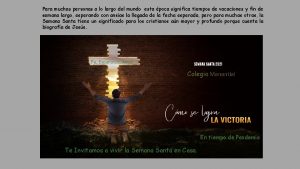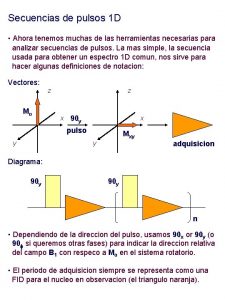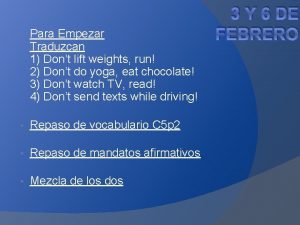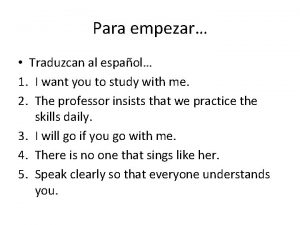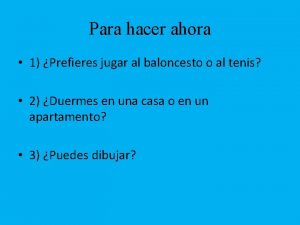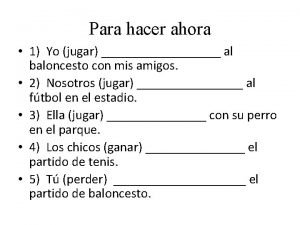Para hacer ahora Traduzcan 1 Hay muchas personas





















- Slides: 21

Para hacer ahora Traduzcan 1) Hay muchas personas en el museo. 2) Mi amigo y yo vamos a practicar tenis a las después de las clases. 3) La estudiante es muy inteligente. 4) Los estudiantes estudian la historia de los Estados Unidos en la escuela. 5) Yo tengo una pelota de beisbol en mi casa.

Para hacer ahora Traduzcan 1) There are many people in the museum. 2) My Friends and I are going to practice tenis after school. 3) The student is very intelligent. 4) The students are studying the history of United states in class. 5) I have a baseball at home.

Hoy es _____.

Cita de hoy

Unit 7: ¡Vamos de Compras! Let’s go shopping! Unit Goal: Students will be able to talk about the clothing they wear, ask for and give help in the store, ask for and give opinions, and be able to make store purchases.

Topic: Prepositional Pronouns or Prepositions Essential Question: How do you express where things are located? Today’s Objective: Use the verb “estar” with prepositions

So what are prepositional pronouns? They’re pronouns that follow prepositions. These days the next question is “What are prepositions? ” You shouldn’t reach college without knowing what prepositions are!

Prepositions are words that show the relationship between other words. The boy with the gorgeous smile is my brother. “With” shows the relationship between “boy” and “smile. ” He lives in Alaska. “In” shows the relationship between “lives” and “Alaska. ”

In English, prepositions are usually, but not always, short words: of to in for over from at near under with BUT between during beside outside beneath before inside

A large number of Spanish prepositions have “de” with them: después de--after debajo de--under al lado de--beside fuera de--outside antes de--before cerca de--near dentro de--inside

Uses of preposition “de” abajo de — underneath a bordo de — aboard a cambio de — in exchange or trade for a cargo de — in charge of a causa de — because of acerca de — about, concerning además de — besides, in addition to, as well as adentro de — inside a excepción de — with the exception of, except for en medio de — in the middle of en vez de — instead of por causa de — because of lejos de — far from a falta de — due to the lack of, in the absence of a fin de — with the goal or intent of, in order to afuera de — outside al contrario de — contrary to al estilo de — in the style of, in the manner of al frente de — at the forefront of al lado de — next to alrededor de — around antes de — before (in time, not location) a pesar de — in spite of a punto de — on the verge of a través de — through, across cerca de — near debajo de — underneath, under delante de — in front of dentro de — within después de — after detrás de — behind, after en caso de — in case of encima de — on top of en contra de — against en lugar de — instead of, in the place of

Other common prepositions: entre—between en—in, at, on de—from a—to para--for con—with sobre—on, about durante—during por—for, by

In English, direct object pronouns (d. o. ), indirect object pronouns (i. o. ), and prepositional pronouns (p. p. ) are all the same: me you him, her, it d. o. us them, y’all i. o p. p. Juan sees me. /Juan gave me the rose. /Juan lives near me.

In Spanish, however, there are three different sets: direct me nos te lo, la los, las indirect me nos te le les prepositional mí ti él, ella, Ud. nosotros ellos, Uds.

Let’s look at those again: prepositional mí ti él, ella, Ud. nosotros ellos, Uds. They look a little familiar. That’s because, with the exception of “mí” and “ti, ” they’re identical to SUBJECT pronouns: yo tú él, ella, Ud. nosotros ellos, Uds.

“Mí” probably also looks a little familiar. That’s because you’ve had “mi. ” Remember what it means? “My”—mi casa. So the accent mark is important. It makes the difference between a prepositional PRONOUN (mí) and a possessive ADJECTIVE (mi).

So it’s simple. Whenever you have a preposition and need a pronoun after it, use one of these: prepositional mí ti él, ella, Ud. nosotros ellos, Uds.

Let’s see what these pronouns look like in context: Juan habla con ella. Yo compro un libro para ti. Elisa vive cerca de mí. La carta es de nosotros. El cuaderno está debajo del pupitre. La mesa está detrás de ella.

And you’ll never guess how you’ll be tested over it: multiple choice! But there’s a catch. You’ll have direct objects, indirect objects, reflexives, subjects, and possessives mixed in there. So it might be a good idea to review them.

prepositional mí ti él, ella, Ud. nosotros ellos, Uds. subject yo tú él, ella, Ud. direct object me te lo, la ellos, Uds. indirect object nos los, las reflexive me te se nosotros me te le nos les possessive ADJECTIVES nos se mi tu su nuestro su

Click here to go to your first homework exercise. Click here to go to your second homework exercise. Below are links to other pronoun lessons: Direct objects Indirect objects Reflexive Subject Possessive ADJECTIVES
 Saco mi vida del anonimato me dio corona
Saco mi vida del anonimato me dio corona Ministerio de salud personas que atendemos personas
Ministerio de salud personas que atendemos personas Ministerio de salud
Ministerio de salud En que consiste el intelectualismo moral de socrates
En que consiste el intelectualismo moral de socrates Dialecto mexicano
Dialecto mexicano Hay dos tipos de personas las que hacen cosas
Hay dos tipos de personas las que hacen cosas Cuales han sido mis logros proyecto de vida
Cuales han sido mis logros proyecto de vida Hay nos hablan
Hay nos hablan Existen personas en nuestras vidas que nos hacen felices
Existen personas en nuestras vidas que nos hacen felices A veces llegan personas a tu vida
A veces llegan personas a tu vida Hay personas en la vida
Hay personas en la vida Palabras bonitas
Palabras bonitas Televisor palabra
Televisor palabra Hay dias llenos de viento hay dias llenos de furia
Hay dias llenos de viento hay dias llenos de furia Vvela
Vvela Hay momentos en la vida que hay que sonreír
Hay momentos en la vida que hay que sonreír La vida te da momentos
La vida te da momentos Hay momentos en la vida que hay que sonreír
Hay momentos en la vida que hay que sonreír Ay momentos en la vida
Ay momentos en la vida Calculo hedonistico
Calculo hedonistico Acrosport 4 personas
Acrosport 4 personas Esquema sobre el amor
Esquema sobre el amor




